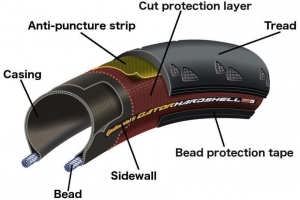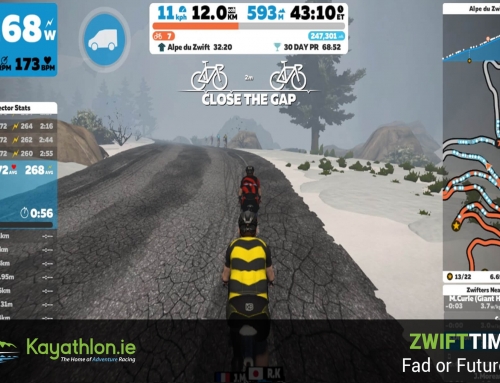For any Adventure Racer one of the most important things you use is your bike…and one of the most important components of your bike is the tyres.

Tyres are your only, and very small, contact with road. It’s important to have a stable and predictable tyre in all conditions especially in Adventure Racing where the conditions and road surfaces can at times be less than favorable. When you are hurtling down a back road in Connemara, Crolly, Laragh or through The Black Valley at 70kmph the only thing that is separating you from the road is a few mm of rubber, when you are rounding a corner descending the Conor Pass or down off Knockalla you are relying on those few mm of rubber to keep you upright and stuck to the road. As Adventure Racers we tend to be presented with mixture of tough geographical conditions in our races and our tyres need to take all those stresses and strains in their stride.
Choosing the right tyres is essential, they can help with ride comfort, increased grip and better rolling resistance. There are many things that can go wrong with a tyre….you can get a puncture for example and a puncture can mean many things to different people…. a puncture which takes 5 minutes to repair can be the difference between 1st and 20th place, for someone that can’t repair a puncture it can mean you are stranded…or it can just mean you are at the side of the road doing something you don’t want to be doing (maybe in the lashing rain). Things can get more serious than a puncture though if your tyres are worn or damaged, loss of control though reduced / no grip or the handling not reacting how you want it to could cause an accident potentially injuring you or others.
Let’s have a look at the main categories of tyres…there are 2 main types – Clinchers and Tubulars.
Clinchers
Clincher tyres are the tyre most of us are familiar with and can be found on the vast majority of road bikes. They are shaped a bit like a horseshoe (or U shaped) and have a bead along the edge which clinches to the rim of the wheel and hence where they get the name. This bead is held in place by the air pressure in the tyre. Sometimes this bead is made from kevlar and this is then called a folding tyre….when the bead is made from wire then it’s not foldable so it’s called a rigid tyre. The folding clincher tyre is a little more expensive usually as it is lighter but costs more to make. Relatively new to the road bike scene are tubeless clincher tyres. These have been around the mountain bike scene for a while but are becoming more popular in road bike tyres now. They look very similar to tubed clinchers but the bead design is a little different and they are designed to fit to the rim very tightly (note: the rim must be a tubeless compatible rim, check the spec on your wheel) and be they must sit completely air-tight (note: this usually involves a special type of rim tape and a tubeless valve). Tubeless tyres do not need an inner tube. A sealant liquid is put in to the tyre to plug any small holes and splits and this reduces the chance of puncture and in particular the ‘pinch’ type puncture a normal clincher may get (where the inner tube is ‘pinched’ by the tyre hitting a stone or pothole for example and causes a puncture). Tubeless tyres are said to give better rolling resistance and also run at lower pressures, improving grip, comfort and control.

Tubular Tyres
Tubular tyres are not very common and tend to only be used mainly by professional riders. The tyres are mounted on special tubular specific rims. Tubular tyres still use an inner tube but it is sewn into the tyre rather than sitting separately from it like a clincher, so tubulars have to be stuck to the wheel with a special tape or glue. The biggest issue with these is the lack of everyday functionality…changing a punctured tubular is not easy, especially at the side of the road in the rain. You can’t just change out the inner tube for a new one like you would with a clincher, you would need pre-glued tubular tyre, which you obviously wouldn’t be carrying. You can however ride gently on a flat and maybe get home as the tyre will stay on the rim and you can continue to ride without losing control so this is a big advantage for the professionals and those racing.

Tyre Size
Road tyres normally come in three widths: 23c, 25c and 28c – this number refers to the width of the tyre at their widest point (in mm). A larger width tyre offers better comfort, grip and a lower rolling resistance. Up to recently 23mm was standard but now 25mm tyres are the norm….and many are riding on 28mm. While 25mm is probably the best compromise between comfort, weight and performance, if like most of us you are riding rough roads (which is probably most Irish roads?) or you’re not built like a pro cyclist (most of us fit in this non pro category?) then 28mm tyres would be a better choice.
Ensure your tyre is pumped correctly…the recommended PSI value will be on the side of the tyre wall…if you are using 25mm/28mm then you should tend to use the lower end of this.
SUMMARY
Safety is paramount, a puncture may be inconvenient but you don’t want to crash and potentially injure yourself or others. Don’t skimp on tyres…they are all that separate you from the road and saving yourself €20 on a cheap crappy tyre just isn’t worth it in the long run. There is a huge variability in how long a tyre will last (so many factors at play), can be anything from 1,000km to 10,000km. With so much variability it’s important to know how to check for tyre wear and replace when appropriate. Some manufacturers will specify a distance range but depending on the road surface, the overall load, riding conditions and tyre pressure, tyres may wear prematurely, so use the recommendations as a guide and trust your judgment if you think it’s time to change them. A lot of the new tyres out now will have wear indicators in the form of small holes in the centre of the tyre to indicate the amount of tread left. Once you can no longer see the dots, your tyre is well and truly worn. As a rule, if you can see the puncture protection belt or the casing of the tyre, it’s time for a replacement but please please don’t let it get that far?. One of the first signs the tyre is wearing is a squaring off of the tyre through the centre (flat top).
Invest in a premium tyre….we ride on Continental GP4000 / GP5000 25/28mm and have been for several years, we find these the best in terms of grip, puncture resistance and durability. For the winter we ride Continental GP 4 Seasons and Gatorskins. While we recommend these and use them ourselves, the really important thing is to have a premium tyre on your bike, it might not be Continental, but make sure that it’s a premium brand and is fit for purpose and not worn or frayed in any way….check the wear on the tyres, make sure the side wall is not damaged. Cheap and bargain basement is not the way to go when it comes to tyres!!!







Leave A Comment